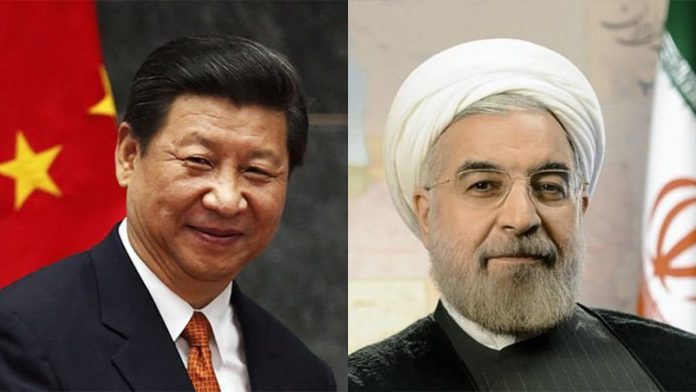The deal would make way for about $400 billion worth of Chinese investments into Iran’s key sectors, such as energy and infrastructure, over the next 25 years.According to US officials, the agreement could also make way for Chinese military bases in Iran, fundamentally changing the region’s geopolitics.ThePrint looks at the proposed deal, what led to it and its implications for the Middle East.
The deal
An 18-page draft of the proposed agreement was accessed and reported by the New York Times (NYT), and it talks about expanding Chinese presence in Iran’s “banking, telecommunications, ports, railways and dozens of other projects”. In return, Iran is to provide regular and “heavily discounted” supply of oil to China for 25 years.
In the strategic realm, the proposed draft talks about deepening military cooperation, with “joint training and exercises”, “joint research and weapons development”, and intelligence sharing.
The deal is reported to have been first proposed by Chinese President Xi Jinping during his 2016 visit to Tehran, and the proposed draft was approved by Iranian President Hassan Rouhani and Foreign Minister Mohammad Javad Zarif over the last couple of weeks.
hese moves come at a time when the Iranian economy has been crippled by sweeping US sanctions, which have ensured that any company in the world that deals with Iran would be cut off from the global financial system.
The deal has not been presented to the Iranian parliament yet, and Beijing is still to disclose the terms of the deal, though Iranian officials have publicly acknowledged that there is a “pending agreement with China”.
What does it entail?
The opening sentence of the proposed draft says: “Two ancient Asian cultures, two partners in the sectors of trade, economy, politics, culture and security with a similar outlook and many mutual bilateral and multilateral interests will consider one another strategic partners.”
There are nearly 100 projects cited in the document that would have Chinese investments, and are expected to be a part of Xi’s ambitious Belt and Road Initiative (BRI), which aims to extend China’s strategic influence across Eurasia.
These 100 projects include “airports, high-speed railways and subways”, effectively touching the lives of most Iranian citizens.
“China would (also) develop free-trade zones in Maku, in northwestern Iran; in Abadan, where the Shatt al-Arab river flows into the Persian Gulf, and on the gulf island Qeshm,” notes the NYT report.
The draft agreement also talks about China building infrastructure for 5G telecommunications network in Iran. This would see Chinese telecommunications giant Huawei — a company that has come under severe US sanctions and been banned by many countries across the world such as the United Kingdom and Australia — enter the Iranian market.
Chinese global positioning system BeiDou is also proposed to assist Iran’s cyber authorities in regulating what is shared in the country’s cyberspace, potentially paving the way for Iran to develop a China-like “great firewall”.
US ‘pushed’ Iran into China’s arms
Since coming to power in 2017, US President Donald Trump has withdrawn from the 2015 Iran nuclear deal, which froze the country’s nuclear programme, and enforced comprehensive sanctions on Iran, devastating its economy. Now “Tehran’s desperation has pushed it into the arms of China”, remarks the NYT report.
“Iran and China both view this deal as a strategic partnership in not just expanding their own interests but confronting the US. It is the first of its kind for Iran, keen on having a world power as an ally,” said Ali Gholizadeh, who works at University of Science and Technology of China in Beijing.
Until now, Iran used to seek European cooperation for trade and investment, but it has reportedly grown increasingly frustrated with it.
“The draft agreement with Iran shows that unlike most countries, China feels it is in a position to defy the United States, powerful enough to withstand American penalties, as it has in the trade war waged by President Trump,” said the NYT report.The US State Department spokesperson said the US would continue to “impose costs on Chinese companies that aid Iran”.
Middle East geopolitics
For decades now, the US forces have dominated the Middle East’s security paradigm, but this agreement could now provide China with a foothold in the region, according to unnamed US officials in the NYT report.
Analysts contend that when China develops strategic ports in various countries, there is a possibility that it might militarise them at some point.
In the proposed draft, China plans to build several ports in Iran, one of them at Jask, just outside the Gulf of Hormuz, which is the entrance to the Persian Gulf.
The Gulf of Hormuz is among the nine key maritime chokepoints across the world. All of these chokepoints are controlled by the US, which many security analysts believe is a marker of US strategic hegemony over the world.
Now, a Chinese port at Jask “would give the Chinese a strategic vantage point on the waters through which much of the world’s oil transits. The passage is of critical strategic importance to the United States, whose Navy’s Fifth Fleet is headquartered in Bahrain in the gulf,” the NYT report states.


























































































